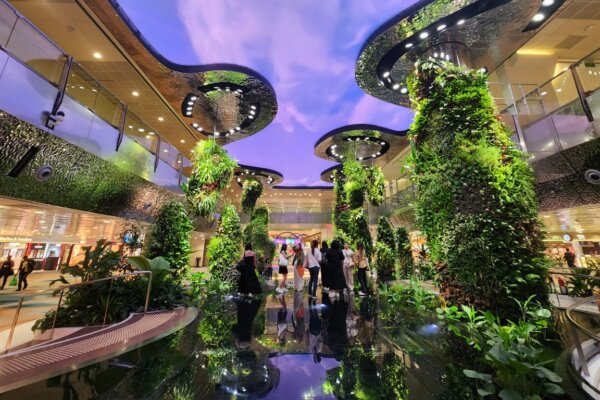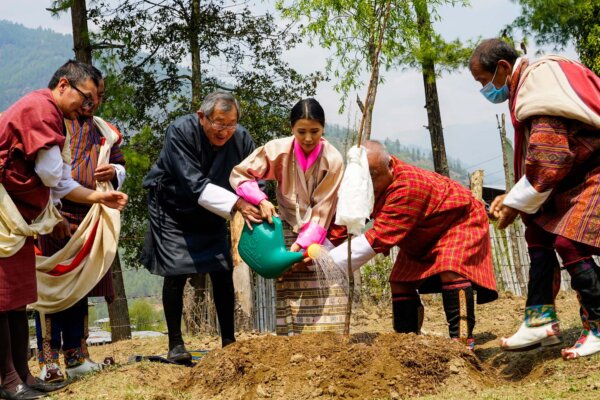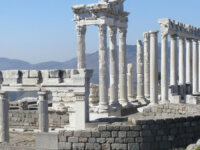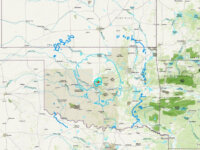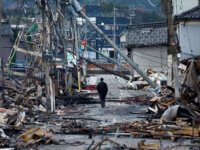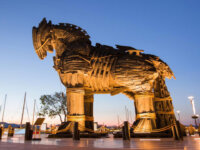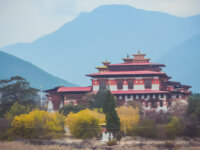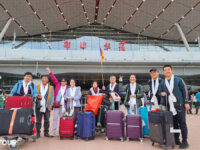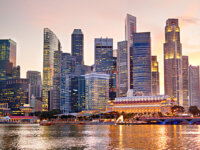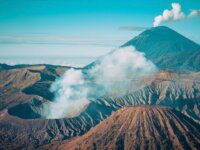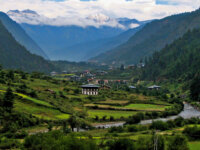BHUTAN – Have you ever dreamed of traveling to Bhutan or wondered what it would be like to visit this remote kingdom nestled in the Himalayas? From Buddhist temples and fortresses to Bhutanese cuisine and trekking in the Himalayas, everything here has a mystical and legendary quality steeped in Buddhism.

Young Bhutanese Monks
We delve into essential Bhutan travel experiences, things to do, and places to visit. Additionally, we answer all your questions about traveling to Bhutan, including the best times to visit and how to obtain a Bhutanese visa.
Marvels await, including diverse biodiversity and remarkable landscapes, long-distance hikes, trekking routes, river expeditions, and cultural activities where locals offer butter tea and spicy food when you step into their homes.

Taking Photos with Monks in Bhutan
Traveling to Bhutan can be costly, but the unique experiences it offers are well worth it.
Best Bhutan Travel Destinations to Explore
Bhutan is a place to admire the breathtaking beauty of pristine nature and intricately adorned temples. The best places to explore in Bhutan are its renowned landmarks. It may sound simple, but it’s the best approach when traveling to this unfamiliar land.

Tourists Taking Photos at a Bhutanese Monastery
The Most Beautiful Tourist Destinations in Bhutan
Thimphu
https://www.instagram.com/p/CWX66e3v6gH/
Allow us to introduce you to Bhutan’s capital, Thimphu, situated in the western region of Bhutan. Capital cities aren’t always appealing to tourists, but Thimphu is a destination you shouldn’t miss.
The Tashichho Dzong government building is impressive at first sight. You can explore the city with mountains on both sides, walking along narrow streets with traditional Bhutanese buildings.
Visit the giant gold-seated Buddha statue perched on a hill. Enjoy the sunset here, then head to Mojo Park to interact with street performers.
Paro
https://www.instagram.com/p/CdG2m2wOte6/
Just over an hour’s drive from Thimphu, you’ll arrive in Paro, one of Bhutan’s most famous destinations, as it serves as the gateway to the Tiger’s Nest Monastery. This iconic religious structure perched on a mountainside is often the highlight, but there are plenty of sights to see in Paro.
A 16th-century monastery lies just outside Paro, and then you can visit the Paro market and the unique 108-chorten strip built beside it. Regardless, you’ll end up in Paro because it’s the only international airport.
Punakha
https://www.instagram.com/p/Ccu_mE_h2f0/
To the northeast of the capital, you’ll reach a lush, vibrant valley surrounded by mountains and natural beauty.
A standout feature in the surrounding area is Khamsum Yulley, an intricately decorated Buddhist monastery with small stupas lining the impressive Punakha Valley.

Punakha Dzong Bhutan
Alternatively, you can venture into the wilderness on a 10-hour hike leading to the Gasa Tsachu hot springs—a well-deserved rest after a long journey. Punakha itself is the confluence of two major rivers, and a 17th-century fortress still occupies a significant portion of the city.
Phrumsengla National Park
https://www.instagram.com/p/CSrEySkpmwL/
Bhutan’s characteristics include protecting its land, so it’s no surprise that there are several national parks. Phrumsengla National Park boasts the most spectacular sunset views over mountain peaks and fields of rhododendron flowers if you visit from April to June.
The pristine natural landscapes will steal your heart as you explore rocky outcrops and stumble upon majestic waterfalls.
This area is vast, and you can engage in 5-day treks and still not reach the other side. For avid hikers and mountaineers, Phrumsengla National Park should be on your itinerary.
Eastern Bhutan
https://www.instagram.com/p/CblEYzoBsbH/
Traveling to the eastern part of Bhutan isn’t easy, and because it’s challenging to access, you can imagine the untouched wonders waiting for you.
Few people reside in this wild region, so when you visit its small villages, you’re more likely to encounter more flora and fauna than humans.
You might stay in Trashigang, a trading point between neighboring countries and a quaint town surrounded by natural wonders.
Nearby, the Bumdeling Wildlife Sanctuary is home to magnificent creatures, including red pandas, snow leopards, tigers, and it serves as a hotspot for butterfly activity.
When in eastern Bhutan, you can visit Bhutan’s oldest town near the Indian border, Samdrup Jongkhar, where Indian, Tibetan, and Bhutanese cultures converge. Bhutan may feel off the beaten path, but eastern Bhutan takes it a few steps further.
Trongsa Dzong
https://www.instagram.com/p/CYlg0B0pkoP/
In the heart of Bhutan, you’ll find Trongsa, a captivating town with a massive dzong complex that draws tourists for its serene ambiance and grand scale.
Trongsa Dzong is the largest fortress in Bhutan, strategically perched overlooking a mountain pass and the Mangde River. Like all dzongs, this building serves as the residence of monks and also functions as the government headquarters for its district.
It’s no surprise that it’s on the UNESCO World Heritage tentative list. Visiting this unique place evokes a sense of being at the top and center of the entire universe. Moments of meditation come easily here.
Phobjikha Valley
https://www.instagram.com/p/Ccmb72sJdkn/
If you’re traveling eastward from Thimphu, you’ll pass through Phobjikha Valley, a worthwhile stop for an afternoon. This beautifully high-altitude wetland is a glacial valley shaped like a bowl by the Black Mountain Range to the east.
Some pleasant winding trails around the area, where you’re sure to spot black-necked cranes foraging.
These birds are highly revered in Bhutan, so respect them and their habitat (in fact, you might get into trouble if you disturb these birds). Immerse yourself in the local culture when in the area, enjoy some yak butter tea, and savor the tranquility of Bhutan.
As you continue eastward, you’ll stop at Wangdue Phodrang, a town built at the confluence of the Punak Tsang and Dang Rivers. Here, you’ll find one of the largest dzongs in the country.
Jigme Dorji National Park
https://www.instagram.com/p/BydFlu8loEN/
As one of the largest national parks in Bhutan, a visit here will be a feast for your eyes and soul. This place offers stunning panoramic views of glaciers, rivers, snow-covered mountains, and wildflowers such as blue poppies, rhododendrons, and orchids.
You can easily spend a few days here exploring the hiking trails leading to hot springs, the best bird-watching spots, and perfect outdoor adventure locations.
There are no accommodations within the park itself, but inquire with your tour operator to find nearby lodging options, as Jigme Dorji National Park is a must-visit destination in Bhutan.
Bumthang Valley
The Bumthang Valley, often referred to as the “spiritual heartland” of Bhutan, is a must-visit destination for those interested in Bhutanese culture and spirituality. The valley is home to several ancient temples, monasteries, and sacred sites, making it a center for religious pilgrimage.
One of the most significant attractions in the Bumthang Valley is the Jakar Dzong, a stunning fortress that overlooks the valley. You can also explore the sacred Kurjey Lhakhang, which houses the imprints of Guru Rinpoche’s body, and the Jambay Lhakhang, which dates back to the 7th century.
Bhutan’s landscapes, culture, and spirituality make it a unique and enchanting destination for travelers seeking an authentic and immersive experience. Whether you’re trekking through the mountains, exploring ancient monasteries, or simply enjoying the serene beauty of the countryside, Bhutan offers a truly unforgettable journey.
Learn more: Bhutanese Cuisine: Top 6 Must-Try Dishes in Bhutan
Best Things to Do in Bhutan
Bhutan attracts travelers for a multitude of reasons: its uniqueness, mystery, mountainous landscapes, distinctive culture, and allure. Additionally, its geographical location lends itself to outdoor activities, primarily long-distance hiking and forest trekking, including boating, mountain climbing, and Bhutan’s national sport, archery.
Learn more: The Most Beautiful Villages in Bhutan

Villages in Bhutan
Trekking
If you Google “Bhutan” the top search result will likely display an image of the Tiger’s Nest Monastery. As one of Bhutan’s top attractions, you should not miss it on your trip.
To reach this impressive religious complex perched on a cliff above a vast valley, you’ll have to embark on a 5–8 hour hike round trip.
Besides this famous monastery, you can go on long hikes around Thimphu and within the numerous national parks that cover over half of the country.
Some top trekking options include the Phajoding Monastery, providing deep insights into mountain village life, or the challenging Talakha trek that will leave you both breathless and exhilarated.
https://www.instagram.com/p/CdHR9ooPQH-/
For a life-changing journey through the Himalayas, consider the Jomolhari Trek, which takes you up to 5,000 meters in 10 days.
Remember that mountain climbing above 6,000 meters is prohibited in Bhutan. These peaks are considered sacred and off-limits as they are homes to gods and goddesses and should not be disturbed.
Boating and Kayaking
https://www.instagram.com/p/CdYiQL2pFfj/
Not far from Paro, where you enter Bhutan at the country’s sole international airport, you can quickly access two magnificent rivers for thrilling underwater adventures.
Mo Chhu and Pho Chhu (chhu = river) meander through lush vegetation in the Punakha Valley, where you’ll pass by temples, beneath prayer flags, and through Class II, III, IV, and V rapids. From beginners to experts, there’s a stretch of river ready for you in Bhutan.
Mountain Biking and Motorcycling
Thrill-seekers can explore this country on two wheels: bicycles or motorcycles.
You can book a mountain biking adventure as part of your journey, visiting prominent sights around Thimphu, Paro, and the Punakha Valley. You’ll encounter some hair-raising descents, but it will be immensely exciting.
For those seeking more adrenaline, try motorcycle riding. Glide through the mountains on perilous roads, where the breathtaking scenery around every bend will leave you awe-struck.
Warning: Motorcycle riding in Bhutan is not for the faint of heart!
Mountain Climbing
While mountain climbing options in Bhutan are limited, they are still impressive. The massive rock face above the capital, known as “The Nose,” offers 13 climbing routes ranging from 4B to 7B and up to 27 meters long.
All routes are securely anchored, and your climbing guide will fix ropes and harnesses for you.
Another fascinating touring option is a 7-10-day cycling journey from Pokhara to Kathmandu. Stay in charming guesthouses along the way!

Tourist Max Vũ taking photos amidst the mountains in Bhutan
Other thrilling choices include cycling around Annapurna (typically taking 11 days or more) and exploring the Lower Everest Region (5 days or more).
Cultural Activities and Wildlife Watching
It’s no surprise that Bhutan’s wildlife is incredibly diverse. To get a glimpse of the magnificent animal world roaming its landscapes, try out wildlife viewing tours.
Engage in Bhutan’s outdoor activities to learn more about its biodiversity and the types of animals you might encounter.
https://www.instagram.com/p/Cdau-F0IYYx/
Birdwatchers will want to learn how to blink less to catch sight of all the fantastic wild species flying above. You’re sure to spot yaks, livestock, and wild boars, Bhutan’s national animals.
Best Time to Visit Bhutan
https://www.instagram.com/p/CdZv__Wr1Vu/
For outdoor adventures, the best time to visit Bhutan is from October to December and from March to April. In the autumn months in the northern hemisphere, Bhutan offers crisp, clean air, sunny skies, and temperatures ranging from 15–20°C.
For botany enthusiasts, consider visiting Bhutan in spring when meadows burst with rhododendrons and other vibrant flowers.
January and February bring snow and cold, with temperatures dropping below 0°C, but these months still see some tourists—especially photographers. The monsoon season lasts from June to September when mountain ranges are covered in mist and any outdoor activities you want to do become challenging.
Cost of Travel in Bhutan
If you’re planning to travel to Bhutan, you’ll need to save some money. Unfortunately, Bhutan cannot be visited on a shoestring budget.
To minimize environmental impact and preserve local culture, the Bhutanese government requires all tourists to purchase guided tours to visit the country (excluding citizens from India, Bangladesh, and the Maldives).
The Bhutanese government sets a minimum daily fee for each tourist.

Tourist traveler with Guu taking photos during their trip to Bhutan
Here is the breakdown of the daily fee per person for groups of 3 or more:
- $200 USD per person in January, February, June, July, August, December.
- $250 USD per person in March, April, May, September, October, November.
Solo or groups of 2 travelers will incur additional charges:
- $40 USD per solo traveler per day.
- $30 USD per person per day for groups of two.
These fees include all the essentials you’ll need for your trip, including a driver, transportation, accommodation, and any camping equipment you may require.
- Minimum 3-star accommodation (anything above may incur additional fees).
- All meals.
- Licensed Bhutanese tour guide for your entire journey.
- Camping gear and transportation for forest treks.
- Sustainable development fee ($65 USD).
Your money goes into government programs like free education, nationwide healthcare, and poverty reduction. Rest assured that your economic contribution will uplift Bhutan while ensuring that the pristine kingdom isn’t spoiled by an influx of tourists.
https://www.instagram.com/p/CpWQg-btPq1/
You’re expected to wire the total cost of your trip, along with a $40 USD visa fee, to the Bhutan Tourism Council before your departure.
Currency and Tipping
The currency used in Bhutan is the Ngultrum, which is equivalent in value to the Indian Rupee. It’s advisable to carry cash for souvenirs or snacks, especially when venturing into rural areas.
USD may be accepted, but be aware that you might receive Indian Rupees as change.
You can withdraw cash from ATMs at major banks in larger cities using Visa or MasterCard.
Tipping is not mandatory, but leaving a small gratuity for your guide or driver is a gesture of appreciation. Common amounts range from 5–10% of your daily expenses, so budget around $10–$20 per day for tipping.
You should tip your guide and driver separately. If you do leave a tip, place it in an envelope to hand over to the staff.
Visa Requirements for Traveling to Bhutan
Due to its strict regulations for tourists, all international travelers to Bhutan must obtain a visa. When you book a full package tour to Bhutan, this will be part of the process and should be done before your arrival.

Tourist visa card
You must have a valid passport with at least one blank page and a validity of at least six months from the date of departure from Bhutan. Bhutanese visas cost $40 USD for all tourists except those from India, Bangladesh, or the Maldives, who receive a visa on arrival for free.
Safety for Traveling in Bhutan
https://www.instagram.com/p/CpUHLLMrmdG/
Overall, when you travel to Bhutan, you are in a safe environment. Crime in Bhutan is very low throughout the country. While you travel, other threats on the ground include weather patterns, altitude, and a lack of water treatment facilities, among other common minor threats found in any country.
In the mountainous regions, seasonal winds can cause landslides, and trekking conditions may not be favorable. Check the best time to visit Bhutan to avoid certain months due to weather conditions, especially if you plan on extensive hiking.
To ensure a successful high-altitude journey, acclimatize before reaching high elevations. Other mountain safety concerns are winding roads, inadequate lighting, and seemingly precarious cliff-hugging paths.
Road accidents can occur, so always fasten your seatbelt and request your driver to avoid nighttime driving, if possible.
When you spend time in cities and towns, you’ll notice many street dogs around. Even if you love animals, try your best not to provoke them as there is a risk of rabies.

Tourists taking photos at a Bhutanese temple.
Potable water should only be obtained from bottled or filtered sources—tap water is untreated in most areas of Bhutan and can be unsafe to drink.
Additionally, like everywhere else, safeguard your personal belongings. Bhutan is safe, but people everywhere have a “sticky finger” problem no matter where you travel in the world.
https://www.instagram.com/p/CpVN9WnLvhd/
We always recommend getting travel insurance for health and safety purposes before traveling anywhere in the world.
Make sure to check your government’s travel advice for Bhutan. Some areas near the border may have increased tension, particularly in remote southeastern regions.
It’s best to avoid these areas, but if they’re part of your itinerary, make sure to check the latest news before heading in that direction.



